I walk along the steep bank of a raging whitewater stream, and even though the gorge is only about as wide as a highway, the river’s current speed is greater than that of London’s Thames. The deafening roar and rumble of the rushing water is incredible – a humbling reminder of the raw power of nature.
As I round the corner, I am impressed by a completely surreal sight: a yawning chasm has opened up in the riverbed, swallowing the water in a huge whirlpool, creating huge splashes of water. This may sound like a computer-generated scene from a blockbuster action movie, but it’s real.
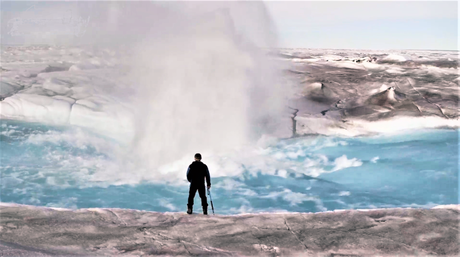
Alun Hubbard stands next to a moulin that forms in a meltwater flow on the Greenland ice sheet. Thanks to Alun Hubbard
Right in front of me, a moulin is forming on the Greenland ice sheet. However, this should not actually happen here – current scientific insights are not suitable for this reality.
As a glaciologist, I have spent 35 years studying how meltwater affects the flow and stability of glaciers and ice sheets.
This gaping hole opening at the surface is just the beginning of the meltwater’s journey through the bowels of the ice sheet. As it flows into the moulins, it bores a complex network of tunnels through the ice sheet that extend many hundreds of meters deep, all the way to the bottom of the ice sheet.
<iframe title="Into the Ice Trailer | CPH:DOX 2022" width="900" height="506" src="https://www.youtube.com/embed/inTPFADBWt0?feature=oembed" frameborder="0" allow="accelerometer; autoplay; clipboard-write; encrypted-media; gyroscope; picture-in-picture; web-share" allowfullscreen="allowfullscreen"></iframe>
When it reaches the bottom, the meltwater decants into the ice sheet’s subglacial drainage system – much like an urban stormwater network, but one that is constantly evolving and developing. It transports the meltwater to the ice edges and ultimately ends up in the ocean, with major consequences for the thermodynamics and flow of the overlying ice sheet.
Scenes like these and new research into ice sheet mechanics challenge traditional thinking about what happens within and beneath ice sheets, making observations extremely challenging yet with major implications. They suggest that the remaining ice sheets on Greenland and Antarctica are much more vulnerable to climate warming than models predict, and that the ice sheets could be destabilized from within.
<iframe title="GRACE and GRACE FO: Observations of Greenland Ice Mass Changes" width="900" height="506" src="https://www.youtube.com/embed/stm1pBp0rfk?feature=oembed" frameborder="0" allow="accelerometer; autoplay; clipboard-write; encrypted-media; gyroscope; picture-in-picture; web-share" allowfullscreen="allowfullscreen"></iframe>
This is a tragedy in the making for the half a billion people who populate vulnerable coastal areas, as the Greenland and Antarctic ice sheets are effectively gigantic frozen freshwater reservoirs holding back more than 65 meters (more than 200 feet) of equivalent global sea level rise. . Since the 1990s, their mass loss has been accelerating, making them both the main contributor and the wild card of future sea level rise.
How narrow cracks become gaping holes in the ice
Moulins are almost vertical pipes that collect and drain meltwater from the ice surface every summer. There are many thousands throughout Greenland, and they can grow to impressive sizes due to the thickness of the ice combined with the exceptionally high melting rates at the surface. These yawning chasms can be the size of tennis courts on the surface, with chambers hidden in the ice below that could swallow cathedrals.
But this new moulin I witnessed is far removed from crevasses and melt lakes where current scientific knowledge dictates they should form.
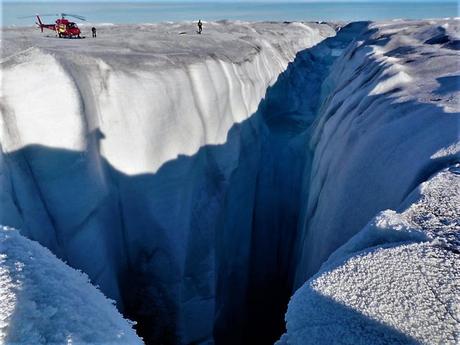
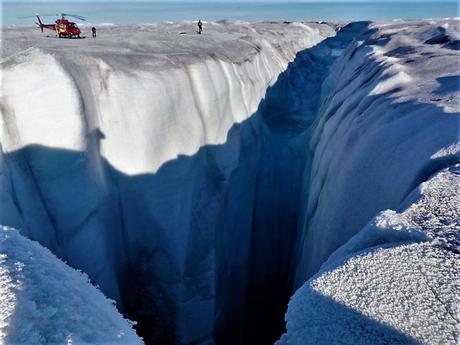
The high meltwater discharge in combination with a thick and gently sloping ice sheet in West Greenland leads to monster holes like this moulin. Alun Hubbard
In a new paper, Dave Chandler and I show that ice caps are riddled with millions of tiny hairline cracks that are pushed open by the meltwater from the rivers and streams they intercept.
Because glacial ice is so brittle at the surface, such cracks are ubiquitous in the melt zones of all glaciers, ice caps and ice shelves. But because they are so small, they cannot be detected by satellite remote sensing.
Under most circumstances we find that flow-fed hydrofracture like this allows water to penetrate hundreds of meters deep before freezing over, without the fracture necessarily penetrating into the bedrock to form a full-fledged moulin. But even these partial-depth hydrofractures have a significant impact on the stability of the ice sheet.
As the water flows in, it damages the structure of the ice sheet and releases its latent heat. The ice tissue becomes warmer and softer and therefore flows and melts faster, just like heated candle wax.
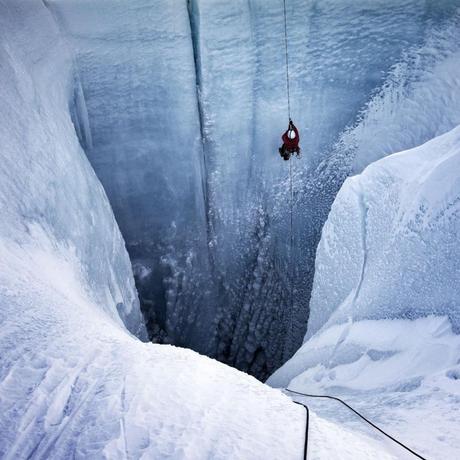

Alun Hubbard abseils into a moulin in October 2019, a point in the year when surface melting should have stopped, but it didn’t. Lars Ostenfeld / In the ice
The current-driven hydrofractures mechanically damage the ice and transfer heat to the viscera of the ice sheet, destabilizing it from within. Ultimately, the internal tissue and structural integrity of ice sheets become more vulnerable to global warming.
Emerging processes that accelerate ice loss
Over the past two decades, as scientists have seriously monitored the melting and flow of ice sheets, melting events have become increasingly common and intense as global temperatures rise—exacerbated by the Arctic warming by nearly four times the global average.
The ice sheet is also flowing, causing icebergs to calve much faster. Since 2002, about 270 billion tons of ice have been lost per year: more than an inch and a half of global sea level rise. Greenland now contributes about 1 millimeter (0.04 in) to the sea level budget on average annually.
A 2022 study found that even if atmospheric warming were to stop now, sea level rise of at least 27 centimeters (nearly 1 foot) is inevitable due to Greenland’s climate imbalance over the past two decades.
Understanding the risks ahead is critical. However, the current generation of ice sheet models used to assess how Greenland and Antarctica will respond to warming in the future do not take into account any amplification processes that are being discovered. That means the models’ sea level rise estimates, used to inform Intergovernmental Panel on Climate Change (IPCC) reports and policymakers around the world, are conservative and the rate of global sea level rise in a warming world is low to hold.
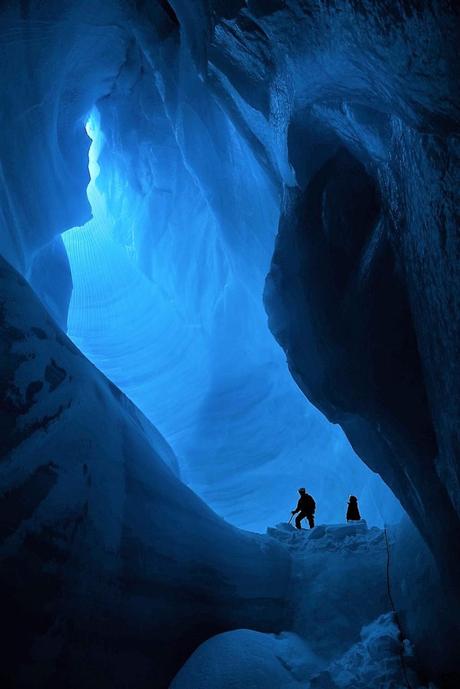
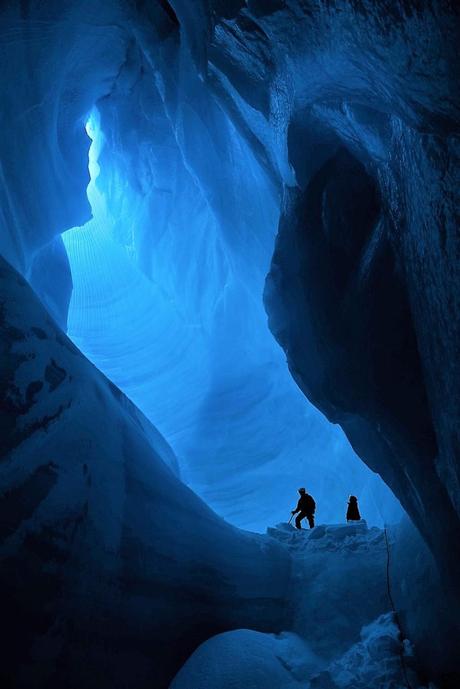
Daniela Barbieri and Alun Hubbard explore the twisted englacial conduits deep within a Greenland moulin. Lars Ostenfeld / In the ice
Our new finding is just the latest. Recent studies have shown that:
In recent months, other papers also described previously unknown feedback processes taking place beneath the ice sheets that computer models cannot currently capture. Often these processes occur at too fine a scale that models cannot pick up, or the simplistic physics of the model means that the processes themselves cannot be captured.
Two such studies independently identify increased submarine melting at the groundline in Greenland and Antarctica, where large outlet glaciers and ice streams flow into the sea and begin to rise from their bottoms as floating ice shelves. These processes significantly accelerate the ice sheet’s response to climate change and, in the case of Greenland, could potentially double future mass loss and its contribution to sea level rise.
Current climate models downplay the risks
Along with other applied glaciologists, ‘structured expert judgment’ and a few outspoken modellers, I argue that the current generation of ice sheet models used to inform the IPCC do not capture the abrupt changes observed in Greenland and Antarctica, or the risks posed are connected to it. forward.
Ice sheet models do not take these emerging feedbacks into account and respond to strong perturbations of warming for millennia, leading to slow sea level forecasts that lull policymakers into a false sense of security. We’ve come a long way since the first IPCC reports in the early 1990s, which treated polar ice caps as completely static entities, but we’re still failing to capture reality.
As a dedicated field scientist, I am acutely aware of how privileged I am to work in these sublime environments, where what I observe inspires and humbles. But it also gives me a sense of anticipation about our low-lying coastal areas and what lies ahead for the approximately 10% of the world’s population that lives there.
This article is republished from The Conversation, an independent nonprofit organization providing facts and trusted analysis to help you understand our complex world. The Conversation is reliable news from experts. Try our free newsletters.
It was written by: Alun Hubbard, University of Tromso.
Read more:
Alun Hubbard acknowledges funding from the Research Council of Norway (Centers of Excellence: CAGE & iC3), the Academy of Finland (PROFI4: Arctic Interactions) and is additionally affiliated with Oulun Yliopisto (Oulu University), Arctic Basecamp and La Venta Esplorazioni Geografiche.
